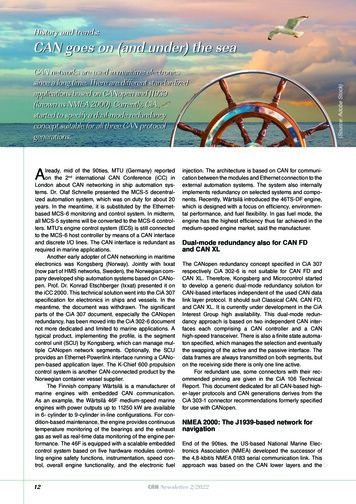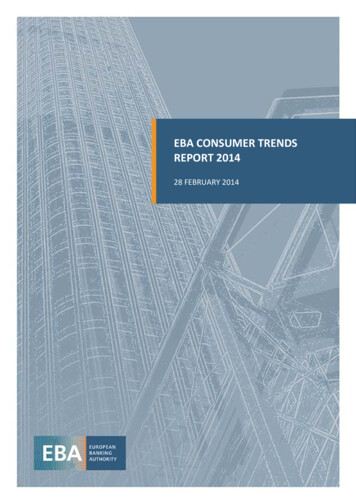
Transcription
History and trends:CAN networks are used in maritime electronicssince a long time. There are different standardizedapplications based on CANopen and J1939(known as NMEA 2000). Currently, CiAstarted to specify a dual-mode redundancyconcept suitable for all three CAN protocolgenerations.Already, mid of the 90ties, MTU (Germany) reportedon the 2nd international CAN Conference (iCC) inLondon about CAN networking in ship automation systems. Dr. Olaf Schnelle presented the MCS-5 decentralized automation system, which was on duty for about 20years. In the meantime, it is substituted by the Ethernetbased MCS-6 monitoring and control system. In midterm,all MCS-5 systems will be converted to the MCS-6 controllers. MTU’s engine control system (ECS) is still connectedto the MCS-6 host controller by means of a CAN interfaceand discrete I/O lines. The CAN interface is redundant asrequired in marine applications.Another early adopter of CAN networking in maritimeelectronics was Kongsberg (Norway). Jointly with Ixxat(now part of HMS networks, Sweden), the Norwegian company developed ship automation systems based on CANopen. Prof. Dr. Konrad Etschberger (Ixxat) presented it onthe iCC 2000. This technical solution went into the CiA 307specification for electronics in ships and vessels. In themeantime, the document was withdrawn. The significantparts of the CiA 307 document, especially the CANopenredundancy, has been moved into the CiA 302-6 documentnot more dedicated and limited to marine applications. Atypical product, implementing the profile, is the segmentcontrol unit (SCU) by Kongsberg, which can manage multiple CANopen network segments. Optionally, the SCUprovides an Ethernet-Powerlink interface running a CANopen-based application layer. The K-Chief 600 propulsioncontrol system is another CAN-connected product by theNorwegian container vessel supplier.The Finnish company Wärtsilä is a manufacturer ofmarine engines with embedded CAN communication.As an example, the Wärtsilä 46F medium-speed marineengines with power outputs up to 11250 kW are availablein 6- cylinder to 9-cylinder in-line configurations. For condition-based maintenance, the engine provides continuoustemperature monitoring of the bearings and the exhaustgas as well as real-time data monitoring of the engine performance. The 46F is equipped with a scalable embeddedcontrol system based on five hardware modules controlling engine safety functions, instrumentation, speed control, overall engine functionality, and the electronic fuel12injection. The architecture is based on CAN for communication between the modules and Ethernet connection to theexternal automation systems. The system also internallyimplements redundancy on selected systems and components. Recently, Wärtsilä introduced the 46TS-DF engine,which is designed with a focus on efficiency, environmental performance, and fuel flexibility. In gas fuel mode, theengine has the highest efficiency thus far achieved in themedium-speed engine market, said the manufacturer.Dual-mode redundancy also for CAN FDand CAN XLThe CANopen redundancy concept specified in CiA 307respectively CiA 302-6 is not suitable for CAN FD andCAN XL. Therefore, Kongsberg and Microcontrol startedto develop a generic dual-mode redundancy solution forCAN-based interfaces independent of the used CAN datalink layer protocol. It should suit Classical CAN, CAN FD,and CAN XL. It is currently under development in the CiAInterest Group high availability. This dual-mode redundancy approach is based on two independent CAN interfaces each comprising a CAN controller and a CANhigh-speed transceiver. There is also a finite state automaton specified, which manages the selection and eventuallythe swapping of the active and the passive interface. Thedata frames are always transmitted on both segments, buton the receiving side there is only one line active.For redundant use, some connectors with their recommended pinning are given in the CiA 106 TechnicalReport. This document dedicated for all CAN-based higher-layer protocols and CAN generations derives from theCiA 303-1 connector recommendations formerly specifiedfor use with CANopen.NMEA 2000: The J1939-based network fornavigationEnd of the 90ties, the US-based National Marine Electronics Association (NMEA) developed the successor ofthe 4,8-kbit/s NMEA 0183 serial communication link. Thisapproach was based on the CAN lower layers and theCAN Newsletter 2/2022(Source: Adobe Stock)CAN goes on (and under) the sea
Compass system for demandingenvironmentsThe Standard 22 NX gyro compass system providesheading information for safe navigation (Source:Raytheon Anschütz)J1939 application layer i.e. using Classical CAN communication with 29-bit CAN-Identifiers. It was named NMEA2000 and internationally standardized in IEC 61162-3 running at 250 kbit/s. The multi-drop network is not completelyinteroperable with all features of the J1939 specifications,but can co-exist in J1939 networks. The cabling is similar to Devicenet specifications. The fast packet transportprotocol is limited to 223 byte and does not require a segment confirmation. CAN in Automation (CiA) is observingthe standardization activities of the NMEA association.According to the organization, there are no plans to migrateto CAN FD or CAN XL.The CAN-based higher-layer protocol and applicationprofile for maritime electronics is especially used in navigation systems. NMEA 2000 products need to be certifiedby the non-profit association. Examples of NMEA 2000 devices include GPS receivers, navigation and engine instruments, nautical chart plotters, wind instruments as well asdepth sounders. Some companies such as Furuno, Raymarine, and Simrad offer other connectors as specified inNMEA 2000. They sell their products not under the brandNMEA 2000, but use the NMEA 2000 parameter groups(PG).NMEA 2000 product suppliersOf course, there are several providers of CAN-supporting hardware, software, interfaces, and services forthe marine industry. The CiA member company Wärtsilä Lyngso Marine (former Søren T. Lyngsø in Denmark)belongs to the Wärtsilä group and develops electronics forthe marine applications. The product range includes automation devices as well as communication and navigationsystems. CANopen, J1939, and NMEA 2000 higher-layerprotocols can be supported.Warwick Control Technologies (UK) provides theJ1939-based protocol stack kit supporting NMEA 2000. Itcomprises the protocol stack in C source-code, an STM32development board, an NMEA-certified reference designCAN driver for STM32 micro-controllers, the X-Analyser tool, and the Leaf Light USB dongle by Kvaser. TheC source-code incorporates such J1939 features as address claim, fast packet protocol, BAM (broadcast announce message), connection management data transfer,Raytheon Anschütz (Germany) developed the modularStandard 22 NX gyro compass system providing heading information for safe navigation. As it needs to operateaccurately and reliably in stressing environmental conditions, the company undergone the device to a rigoroustesting. In addition to the company’s approval test standards, the pre-production units were evaluated for twelvemonths at the company’s production facilities in Kiel, Germany and on a ferry in the Baltic Sea.The system includes NMEA 2000 interfaces for connection of additional heading receivers or of the bridgealert management (BAM). It also enables a direct connection of rate-of-turn indicators. Two Ethernet interfacesare offered as well. The integrated ship-board webserversimplifies the system’s installation. Interfaces are organized by selecting NMEA 2000 telegrams, bit rates, andupdate rates. Also configurations can be downloaded anduploaded via the webserver. This enables configurationtimes of few minutes. The system’s gyro compass accessories include heading distribution units, operator units,and repeater compasses. It can be integrated into thecompany’s existing Standard 22 and Standard 30 MF systems, and added to the redundant CAN networks usingsix wires.etc. The X-Analyser analysis and simulation tool supportsNMEA 2000, J1939, CANopen, and CAN FD. For J1939,it allows to view parameter group number (PGN) packets,compare them to the raw CAN data, and to decode thepackets into fields and signals. It also looks for harness/connector problems in the CAN signal. The analyzer supports all Kvaser CAN interfaces, as well as the Picoscope2206b by Pyco Technology.Figure 2: The wireless CAN bridge byKvaser enables CAN communicationin situations where wired CANconnection is challenging e.g. inmarine applications (Source: Kvaser)Beside of CAN interfaces, further hardware, andtools, Kvaser offers the recent configuration-free KvaserAir Bridge Light HS M12. The wireless CAN bridge withCAN Newsletter 2/202213History and trendsFigure 1: The NMEA 2000 application profile for maritimeelectronics is especially used in navigation systems(Source: Adobe Stock)
History and trendsdust and water-resistant M12 connectors can replace CANcables in marine and other extreme environments. Comprising a pre-configured pair of wireless units with integrated antennas and rugged housings, the bridge exchangesraw CAN data between two networks when a wired CANconnection is challenging. The transmission range is upto 70 m, with a maximum data rate of 1 200 messages persecond and a packet latency of 4,8 ms. Although this model incorporates two 5-pin M12 connectors with NMEA 2000compatible pinning, the bridge is not an NMEA 2000-certified device.The MLI-E 12/1200Lithium-Ion battery fromMastervolt comes in awater proof plastic case,recharges in less thanan hour, and deep-cycles 5000 times, whichis up to 10 times longer Figure 3: For integration inthan for lead-acid bat- maritime power systemsteries. For integration the NMEA 2000 protocolin mobile and maritime is supported (Source:power systems, NMEA Mastervolt)2000 and CANopen protocols are supported. The battery is protected against overcharging, deep discharging, and overheating and comeswith an integrated electronic safety switch. The MLI-E isprovided with integrated battery monitoring, including information about state of charge and time remaining.Connecting measurement equipmentunder the seaFigure 4: The off-shore platforms for oil productionare linked to sub-sea CANopen networks comprisingredundant controllers, different sensors, valves, and otherequipment (Source: Adobe Stock)CAN networks are used not only above the water surface.Under the sea, diverse sub-sea measurement equipmentand control systems can be interconnected via CAN. Forinstance, the off-shore platforms for oil production arelinked to sub-sea trees (nicknamed Christmas trees) comprising redundant controllers, different sensors, valves,and other equipment. These devices are located on theocean ground in depths up to several hundreds of metersand are connected by means of CANopen networks. Suchdevices (also known as SIIS level-2 devices) comply tothe CiA 443 CANopen profile, which was developed and14Solar boat projectCAN-controlled hydrofoils allow the SR02 boat toget elevated over the water line, thus reducing thedrag forces and the energy consumption (Source:Kvaser)Since 2015, cross-degree engineering students atLisbon’s Instituto Superior Técnico work together onthe development of solar-powered boats. The mainpurpose of the Técnico Solar Boat (TSB) project isto participate in worldwide engineering competitions.In the Monaco Solar & Energy Boat Challenge(biggest in the world), the SR02 boat developedby the students took the 2nd place on the podium(A-class) in 2019. The team competed with 34 teamsfrom 14 different nationalities. In a remote competitionin 2020, the students won the innovation prize amongthe eleven participating teams. As there was no furthercompetition in Monaco, the university started itsown Odisseia TSB event, traveling along the Portugalcoast, doing some crossings, and testing the boat’scapabilities.The SR02 boat implements a CAN-based systemto control the motors, the hydrofoils system, and tocheck the state of temperatures, voltages, currents,etc. The hydrofoils allow the boat to get elevatedover the water line, which reduces the drag forcesand the energy consumption. While development, theKvaser Canking software was used to monitor andanalyze the CAN traffic. The Kvaser Memorator Pro2xHS v2 interface and Kvaser Database Editor helpedto log data from the vessel for further analysis. Aself-developed Matlab App allowed to extract requireddata from a .mat file generated with the KvaserMemorator configuration tool. This enabled the teamto evaluate the data from a desired period of time,to see the variables’ change along a travelled distance,or to check the boat position for each instant oftime.The students are currently developing theirthird solar-powered boat SR03, and finishing its firsthydrogen-powered boat São Miguel 01 (SM01), whichwill also use the Memorator Pro 2xHS v2 CAN interfacewith dedicated software.CAN Newsletter 2/2022
is maintained by CiA in cooperation with the SIIS (SubseaInstrumentation Interface Standardization) group. The SIISlevel-1 specifies discrete analog interfaces and the SIISlevel-3 defines Ethernet interfaces.The devices are controlled by an application manager, which is not specified in the CiA 443. Often, two manager entities are integrated into the network providing NMT(network management) “flying” manager functionality asspecified in CiA 302-2. The virtual device concept of theCiA 443 profile enables a SIIS level-2 device to provide asub-layered network or serial links. Thus, it acts as a gateway and provides proxies for the connected functional elements (e.g. different sensors). This means, SIIS level-1devices can be easily integrated into SIIS level-2 networks.Of course, the sub-layered network may also comply withCiA 443. Two different physical layers are specified. Besides the low-power, fault-tolerant transceivers (compliantto ISO 11898-3) optionally high-speed transceivers (compliant to ISO 11898-2) are allowed. The default bit rate is50 kbit/s and the bit-rate of 125 kbit/s is required as well.The SIIS group organizes plugfests, where the interoperability of CiA 443 compliant devices can be proven.only specially trained operators could place them into thewater using the ship’s winch.The IOSB’s AUV called Dedave (Deep Diving AUV forExploration) and resembling on a space shuttle, overcamethese problems. It is capable of diving to depths of 6000 m.The embedded CAN system reduces cabling complexity.It consists of a slim cable to which all control devices,electric motors, new modules, sensors, or test devicescan be connected. Batteries and data storage devices areheld in place by a simple latch mechanism, allowing themto be removed with a minimum of effort. There is also noneed to download data from the processor. Because ofthe weight (less than 700 kg) and size (3,5 m long), fourDedave AUVs can found place in one standard shippingcontainer. Usually there is only enough room for onevehicle. Therefore, larger than usual areas of ocean canbe surveyed in less time. The additional carrying space(ca. 1 m in length) is sufficient for installing further differentsensors for capturing ocean floor survey data.CAN in underwater vehiclesFigure 5: The 3,5-m-long AUV weighs less than 700 kgand provides a slim CAN architecture (Source: FraunhoferIOSB-AST)There is a growing demand for underwater vehicles. Severalthousand meters below the surface, oil companies are prospecting for new deposits and deep-sea mining companiesare looking for valuable mineral resources. The thousandsof kilometers of pipelines and submarine cables need a regular maintenance. Additionally, the marine scientists wouldlike to be able to use robust underwater exploration vehiclesto survey large areas of the ocean floor.To meet these demands, researchers at theFraunhofer Institute for Optronics, System Technologiesand Image Exploitation IOSB in Ilmenau and Karlsruhehave developed an autonomous underwater vehicle (AUV)using internal CAN communication. The development ofthe vehicle, which should be manufactured in large numbers, was finished in 2016. The companies have been using AUVs in deep-sea exploration missions for many years.Formerly used vehicles have been custom-built and expensive. They have had complex structures, which made themdifficult to access by the vessel crew, e.g. when replacingthe batteries. It took also more than one hour to read thelarge observation data files from the UAV’s on-board processor. Many of these vehicles were also so heavy, so thatIn 2017, the Dedave UAV has been licensed by theCanadian maritime technology company Kraken Robotics,who have renamed it to Thunderfish Alpha. Since theend of July, the underwater robot has been helping thecompany to hunt down the Avro Canada CF-105 Arrowinterceptor aircraft in the waters of Lake Ontario. Whilethe aircraft’s development and testing phase, conductedfrom the shore of Lake Ontario, some jet prototypes andtheir parts were scattered over a large portion of the lake.In September, the UAV located the first and shortly aftera second model of the Arrow jet, for which people havebeen looking for 50 years. Based on acoustic echoes, thediving robot generated sonar images in real-time, whichwere analyzed by the experts directly after the dive. Imagedata could be transferred wirelessly, and gave preciseindications of potential item locations.Also in 2016, the 25-students team Sonia of École deTechnologie Supérieure in Montreal started to build an autonomous underwater vehicle using modular CAN architecture inside the vehicle.The hardware within thesubmarine included anavigation system, cameras, six motors, a brightlight, a torpedo launcher (a demonstrator version), and two smallrobotic arms. For con- Figure 7: The Sonia AUV divesnection of the CAN net- with Kvaser interfaces (Source:work to a PC, Sonia has Kvaser)CAN Newsletter 2/202215History and trendsFigure 6: Replica of the Avro Canada CF-105 Arrow(Source: Ken Mist, CCSA)
History and trendsused the Kvaser USB-CAN II interface for many years andthen a Kvaser Leaf Pro HS v2. As Linux users, the teamchose Kvaser CAN hardware because of company’s support for both Windows and Linux. The students used opensource software and have also created an open-sourcepackage for robotic systems that interface with Kvaser devices. The interface is built on ROS (robotic operating system), a popular middleware for robotic projects.For actuation under waterAs an example for CAN-connectable devices deployed insubmarines, Olsen Actuation (UK) provides the OLX linear and ORX rotary actuators withstanding pressures upto 300 bar. Optionally, the devices come with integratedservo drive electronics and multi-axis operation. Furtheroptions include secondary redundant sealing systems,salinity sensors, temperature sensors, and pressure-levelsensors. Manual docking, side- or rear-drive, visual position indication, diverse mounting arrangements, as well asmarine subsea-rated cables are offered. Customization ofthe actuators e.g. regarding housing materials, is possible. OLX and ORX actuators are built around the company’s Exlar GSX actuators, which has been proven time andagain on Virginia Class nuclear submarines. The devicesare suited for applications in submarines such as winchbrake control, winch cable guide control, umbilical cutters,hatch and door actuation, sonar array cutters, and sonarmast deployment. They also find application in pipelineinspection tools, thrusters, and manipulators.TheSpainmanufacturer Ingenia Motion Controlprovides the CANopen i127brushless AC motor servo driveincluding pressuretolerant electronics. Dedicated for ope-rationat up to 1600-m deepness(up to 160 bar), it can be usedfor control of propulsion systemson manned submarines, AUVs,ROVs(remotelyoperatedFigure 8: The CANopenvehicles), or other underwateri127 servo drive isvehicles. The device implementsdedicated for thrusterthe CANopen device profilecontrol on under-waterfor drives and motion controlvehicles (Source:(CiA 402 and IEC 61800-7Ingenia)2/-3). Historically, electronicsystems for deep-water applications have been installedinside of low-pressure vessels. Working with pressuretolerant electronics reduces the weight and volume ofcontainers as well as the number of connections throughpressure barriers. The power and electronic systemsare not placed in the submarine cabin. Less complexand reliable cooling systems are required. Use of suchelectronics also reduces system complexity and increasesreliability. Thereby, several design issues should beconsidered. Full isolation between power and logicconnections should be given. Dynamic braking should bedone through on-board high-power shunt braking resistor.For operation, full disconnection from batteries shouldbe achieved. Furthermore, on-board self-monitoring16Proprietary CAN solution for maritimesystemsVetus (Germany) has designed a proprietary V-CAN(Vetus Controller Area Network) system, which is intended for company’s products only. The company hasalso manufactured gateways,which communicate betweenthe V-CAN system and deThe E-POD propulsionvices implementing J1939 orsolution is one ofNMEA 2000 higher-layer procompany’s exampletocols. The firm assisted theproducts, which can beNMEA organization in the imconnected to the Vetusplementation of thruster andnetwork (Source: Vetus) electric propulsion to operateon that network.The proprietary protocol enables the company to stayin control and maintain the safety factors implementedwithin its products. External control or monitoring byother systems requires manufacturer’s approval. Thiscan be done either via a gateway to the other system,or through approved use of the V-CAN commandstructure.systems for voltage, current and temperature supervisionare required. Protection systems should not providenon-resettable devices i.e. all protections should beelectronic.Summary and outlookCAN is broadly used over and under the sea because ofits high reliability, price-performance ratio, and availableoff-the-shelf hard- and software infrastructure. Advancedstandardization of CAN-based communication interfacesenables simplified development, integration, and replacement of devices.Redundant use of devices and networks is a must forthe maritime applications. CiA and its members is currently working on a generic dual-mode redundancy solution forCAN-based interfaces independent of the used CAN datalink layer protocol. It should suit Classical CAN, CAN FD,and CAN XL.NMEA 2000 uses Classical CAN communication with29-bit CAN-Identifiers. The association is not (yet) willing to use CAN FD and CAN XL. The features of ClassicalCAN (bit-rates of up to 1 Mbit/s and payload size of up to 8byte) seem to be sufficient for such maritime applications.For electronics used under the water, special designissues have to be considered. These relate to the housing robustness, pressure-compensation, isolation of powerCAN Newsletter 2/2022
J1939 analysis for ship telematicsVives recorded data from the GEOxyz maritime vessel(Source: CSS Electronics)Vives is the largest university of applied sciences inWest Flanders (Belgium) with campuses in five studentcities. The university participated in a European-funded project ISHY (implementation of ship hybridization)that wants to achieve 50 % of CO2 reduction on medium ships. The project researches the possibility touse fuel cells, battery supply, and hydrogen in ships inplace of heavy fuels.To calculate the size of the alternative power supplies exactly, the project members needed to know howmuch power the combustion engines deliver at any time.The examined GEOxyz vessel has two engines (portand starboard) interconnected via two J1939 networks.Therefore, the actual engine speed and the actual enginetorque values coming from the two in-vessel networkswere monitored and logged. With those two parametersit was possible to make a power profile of the combustionengines. The CANedge2 data logger by CSS Electronics was used for logging of these parameters. Further, theresearchers wanted to know why the engines require thisamount of power. For this, a third network was set up andthe data was logged by a second CANedge2 device. Onthis network, a GPS (global positioning system) receiver,IMU (inertial measurement unit), wind speed sensor, winddirection sensor, wave sensor (and more) were implemented. The two CANedge2 units uploaded the log filesfrom their SD cards via the 4G mobile network to thethird-party S3 server from AWS. Finally, the data couldbe displayed on a monitor in the office using the Grafanadashboard software tool.Vollständig integrierteAutomatisierung fürmobile Maschinen - X90Komplettes upply, cables and connector protection, and many more.In the meantime, there is a number of companies offeringa long-term experience and support for CAN-based (sub-)marine product developments.t Einfache Handhabung Integrierte SicherheitstechnikAuthorOlga FischerCAN Newsletterpr@can-cia.orgwww.can-newsletter.org Schnellere Entwicklung
Kvaser Canking software was used to monitor and analyze the CAN traffic. The Kvaser Memorator Pro 2xHS v2 interface and Kvaser Database Editor helped to log data from the vessel for further analysis. A self-developed Matlab App allowed to extract required data from a .mat file generated with the Kvaser Memorator configuration tool.











